Sunlight-Readable Solutions for LCD Screens
An increasing number of TFT displays are being used in outdoor applications, such as automotive displays, digital signage, and self-service kiosks. The high-intensity sunlight in outdoor environments often leads to image fading and reduced screen readability, making the visibility of TFT LCD screens in direct sunlight and the lifespan of LCD displays crucial. Rongen Display has been developing sunlight-readable LCD display solutions for many years and is well-versed in this TFT LCD technology.
**Understanding Visibility**
Visibility refers to the ease with which an observer can discern objects, or more scientifically, the relationship between brightness contrast and the human eye threshold. The higher the contrast of an object, the better its visibility.
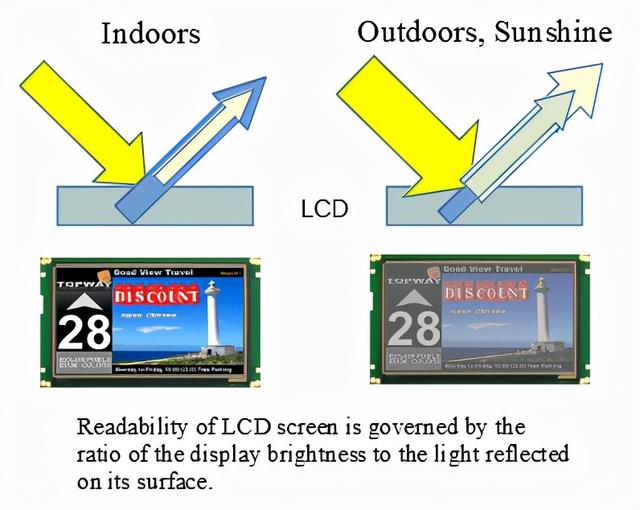 **What Makes LCDs Sunlight-Readable?**
**What Makes LCDs Sunlight-Readable?**
To make LCDs highly readable in bright outdoor environments, the brightness of the LCD screen needs to exceed the intensity of light reflected from the display surface. For comfortable viewing, the LCD's brightness should be at least 2.5 times that of its reflected light.
Naturally, to enhance sunlight readability, two approaches can be taken: increasing brightness or reducing reflection.
**Increasing Brightness for Sunlight Readability**
- **Increasing LED Backlight Brightness:** On a sunny day with direct sunlight, the ambient light intensity is approximately 6000 cd/m2. A typical TFT LCD with a touch screen reflects about 14% of the ambient light, which is roughly 840 cd/m2. Most LCD displays nowadays use LED backlighting as their light source. Increasing the LCD's brightness to around 800-1000 Nits can effectively overpower the sunlight reflection. However, this method may require additional LED backlighting and/or higher drive currents, leading to higher power consumption, increased heat generation, larger product dimensions, and a shorter lifespan for LED backlighting. Increasing the backlight is not an ideal solution for making TFT LCDs readable in direct sunlight.
- **Using Semi-Transflective LCDs:** Semi-transflective TFT LCDs exhibit both transmissive and reflective properties. These displays include partial reflectors between the LCD and the backlight, converting a portion of the ambient reflected light into the LCD's light source, thereby increasing the screen's brightness. However, semi-transflective TFT LCDs are more expensive than fully transmissive ones. Additionally, the partial reflector layer can block some of the LCD's backlight, affecting the display's performance in indoor or low ambient light conditions.
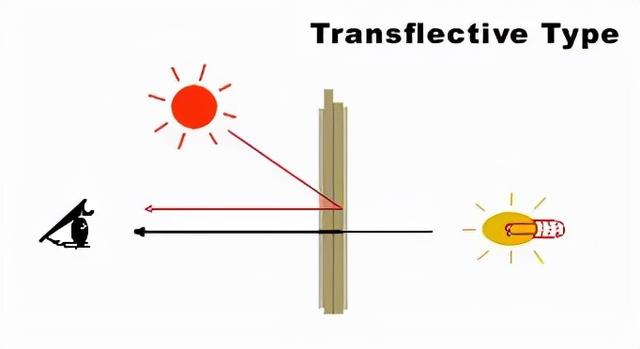 **Reducing Reflection for Sunlight Readability**
**Reducing Reflection for Sunlight Readability**
Reflection occurs when light propagating through one transparent medium encounters the boundary of another transparent medium, causing some of the light to bounce back. By using the basic Fresnel equations, we can calculate the amount of reflected light:
R = [(n2 - n1) / (n2 * n1)]^2 (n1 & n2 are indexes of refraction for the 1st and 2nd material)
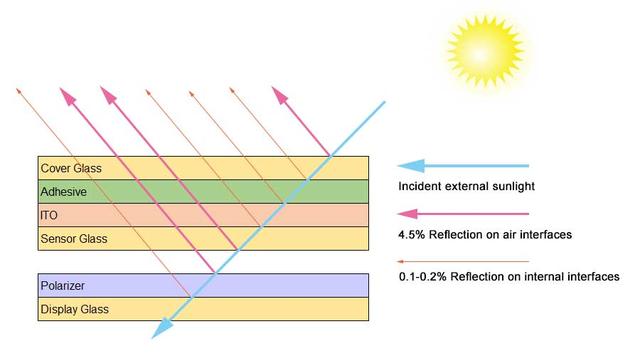
It is evident from the equation that the greater the difference between the two materials, the higher the reflection. In the case of TFT LCDs with touch panels, the total reflectance is the sum of reflected light at any interface where the two materials meet. For instance, the refractive index difference between the polarizer and the display glass is quite small, approximately 0.1, resulting in only 0.1% reflected light. However, as indicated by the Fresnel equations, the focus should be on reducing reflection at the air interface. The refractive index for air is 1, while for glass, it is 1.5. This leads to a reflection of 4.5%. Thus, the three air interfaces contribute the most to the reflectance of TFT LCDs, approximately 13%.
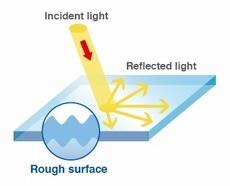 **Reducing Reflection at the Top Layer Panel**
**Reducing Reflection at the Top Layer Panel**
The quickest and simplest way to reduce reflection at the air-glass interface is by applying anti-reflective (AR) or anti-glare films on the top layer of the TFT screen. These outer films with AR properties not only reduce reflections but also offer additional benefits. For applications in the food industry, where glass breakage is a significant concern, LCD screens with external films effectively address this issue. In automotive applications, LCDs with top AR films ensure the safety of passengers during accidents when the shattered glass is less likely to harm them. However, the top layer film typically reduces the surface hardness of the TFT LCD and is prone to scratches. On the other hand, anti-reflective films maintain the LCD's hardness and touch performance but come at a higher cost. These methods can reduce the top layer's reflectance by 2-3%.
**Reducing Incoming Environmental Light into the LCD**
Another quick and straightforward solution to reduce reflection is to affix a linear polarizer film on top of the TFT screen. When environmental light reaches the top polarizer film, only half of it passes through, resulting in a 50% reduction in reflected light. This is a cost-effective way to increase the contrast and readability of TFT LCDs in sunlight. However, adding any film on top reduces the surface hardness of the LCD and may cause transmission losses. These solutions are not ideal.
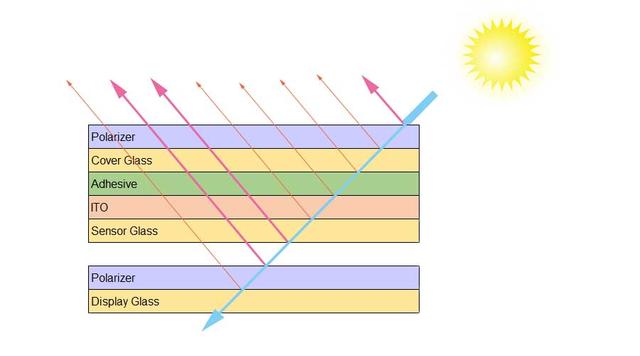 **Blocking Reflected Light**
**Blocking Reflected Light**
Applying a circular polarizer film on TFT liquid crystal displays can eliminate a significant amount of reflection. This is because when environmental light passes through the circular polarizer, it becomes circularly polarized. When it reflects, the polarization direction is reversed by 180 degrees. As a result, the reflected light does not pass through the circular polarizer and is not visible to observers. This method is highly effective in improving the readability of LCD displays with resistive touchscreens. Resistive touch LCDs have two air gaps: the gap between two layers of ITO and the air gap between the touch panel and the LCD screen. Both air gaps cause high reflectance, and applying a circular polarizer can block most of the reflected light, making LCD screens readable in sunlight.
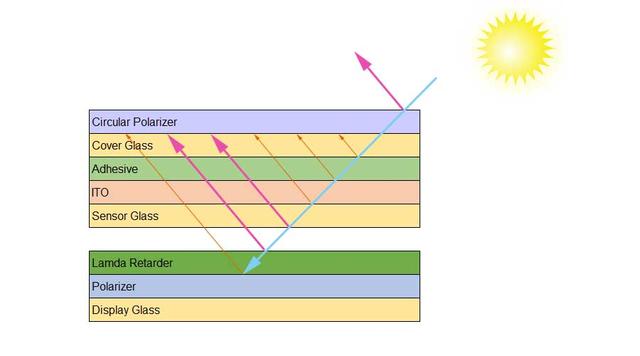
The drawback of this solution is its cost. Not only does it require a circular polarizer film, but it also needs a retardation film on top of the LCD screen to ensure that the light from inside the LCD is not blocked by the external circular polarizer.
**Reducing Reflection from Air Gaps**
Reflection from air gaps is the primary cause of poor readability in sunlight. There are two ways to improve this issue. One way is to add AR films on both interfaces of the internal air gap. These additions can reduce the reflectance in this area from 8.5% to 2%. Additionally, since these AR films are not external-facing, they are more cost-effective than external films. Retaining air gaps also facilitates the maintenance of touch panels or LCD screens.
The most effective method is to completely eliminate air gaps by using optical bonding. In simple terms, a special optical adhesive is used to fill the gaps, making the refractive index difference in this area smooth. This reduces the reflectance caused by internal air gaps from 8.5% to 0.5%. Optical bonding is an expensive but effective way to enhance the sunlight readability of TFT LCDs. It enhances durability and impact resistance. Moreover, the absence of air gaps means no moisture condensation and fogging.
**In Conclusion**
There are many ways to make TFT LCDs readable in sunlight, each with its advantages and disadvantages. With 10+ years of experience in LCD design and manufacturing, Rongen Display knows how to create the best sunlight-readable TFT LCDs for challenging environments. Please feel free to contact us at
[email protected], and we can provide you with the right TFT display solution.






